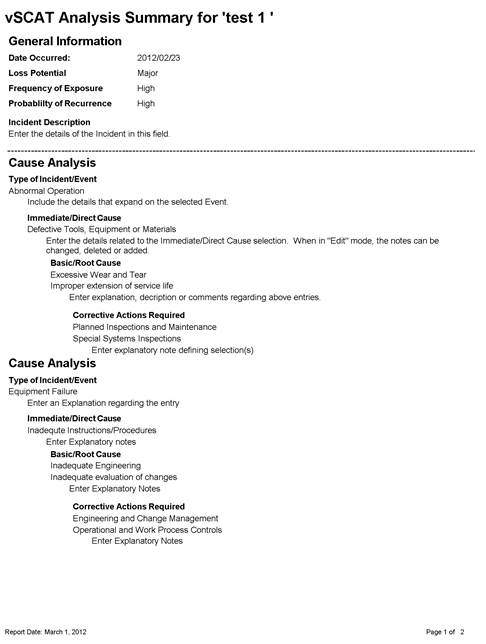vSCAT™ (Safety SCAT®, Quality SCAT® and Environmental SCAT®)
This software version of SCAT® allows you to use the causal analysis methodology that is the commonly accepted standard for Incident Root Cause Analysis. Many safety and risk management organizations have adopted this standard worldwide. vSCAT™ uses the standard created by DNV GL called Systematic Cause Analysis Technique or SCAT®. The Incident report is created and defined through the “General” tab and analysed, along with the SCAT® Charts, through the “Analysis” tab. The SCAT® Definitions and Help menu guide you through the process from the “Incident/Contact”, “Immediate/Direct Causes” (including Substandard Acts & Substandard Conditions), “Basic/Root Causes” (Including Job Factors and Personal Factors) to “Corrective Actions”. Comments can be included at each level defining the details of each specific factor. As there is always more than one cause for any Incident, you will be able to print a report defining each Causal Analysis String including Event, Direct Cause, Root Cause and subsequent Corrective Action related to the event you are investigating.
General Tab
The General Tab collects the standard data required for the administrative details of the Incident Investigation. If vSCAT™ is being used in addition to another incident investigation system, the General tab can become the reference page or title page for the causal analysis section of the investigation.

Figure 1 - General Tab
1. Case Name – A unique title or name (max 25 characters) for this Incident.
2. Loss Severity Potential – The level of potential loss of this Incident.
3. Date Occurred - The date the Incident occurred.
4. Frequency of Exposure – The regularity of this occurrence.
5. Probability of Recurrence - The potential for the incident to recur.
6. Incident Description – Full explanation of the incident.
7. General Help - Help with actions and definitions within the Tab.
8. Field Help – Help definitions for data entry within each field.
Analysis Tab
The Analysis tab is divided up into four sections. Each of these sections contains a list of options that can be selected to describe each stage of the Incident. These lists are hierarchical in nature and each entry in a given section directly relates to the entry in the section above it.

Figure 2 - Analysis Tab
1. Type of Event: Incident/Contact- Select the type of Incident or type of Contact that
occurred.
2. Immediate/Direct Causes- Select the Immediate/Direct cause related to the Incident or Contact.
3. Basic/Root Causes – Select the Basic/Root Causes related to the Immediate/Direct Causes .
4. Corrective Actions Required- Select the Corrective Actions related to the Basic/Root Causes.
5. General Help - Help with actions and definitions within the Tab (Form).
6. Field Help – Help definitions for data entry within each field.
7. Add Button- Add a new selection from the lists.
8. Edit Button- Edit the comments or change an existing selection.
9. Delete Button- Delete a selection or comments.
SCAT Item Detail
The SCAT Item detail is where you add the Type of Event: Incident/Contact, Immediate/Direct Causes, Basic/Root Causes, Corrective Actions Required. For each item that you add to your vSCAT™ record you can also add an Explanatory Note for added detail.

Figure 3 - SCAT
Item Detail
After making your desired selection and optionally entering more detailed information you can save your work. The new SCAT item will now will be displayed in the selected row in the list in the Analysis Tab. This operation is the same for the Immediate/Direct Causes, Basic/Root Causes, Corrective Actions Required lists.
Printing vSCAT™ Report
Finally after completing the analysis you can save and print a vSCAT™ Report which will allow you to have a hard copy of the electronic record.

Figure 4 - vSCAT™ Report